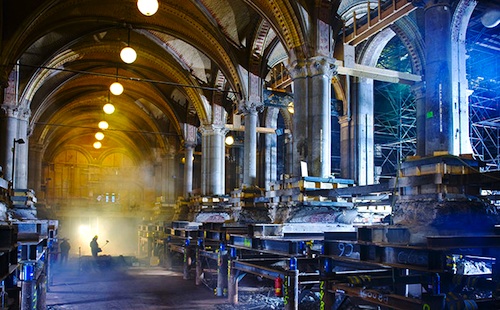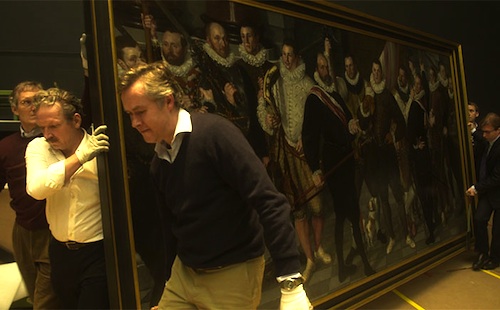
By Joe Bendel. Its restoration ran about five years late and millions of Euros over budget. For roughly ten years, the Rijksmuseum and its Vermeers and Rembrandts were closed to the public, frustrating art lovers and hardly doing any favors for Dutch tourism. Blame the Dutch Cyclists Union. In order to save their members a small detour, they successfully blocked the museum’s initial renovation plans with the local authorities, handing the institution the first of its many costly setbacks. Oeke Hoogendijk witnesses them all and documented them in the observational epic The New Rijksmuseum, which has its world theatrical premiere this Wednesday at Film Forum.
Nobody thought the process would take as long as it did, especially Hoogendijk. Eventually, she distilled two hundred seventy five hours of film into two hundred twenty eight minutes of film, which Film Forum will screen as two distinct parts. Essentially, the two parts are evenly divided by the stewardships of two very different general-directors. As part one opens, Ronald de Leeuw has boundless optimism for the Rijksmuseum’s recreation, considering the objections of the Cyclists Union baseless and parochial. He was right on the merits, but wildly naïve on the political realities.
For years, 13,000 cyclists had availed themselves of the bike thoroughfare running beneath the museum and they had no intention of stopping, regardless of the Rijksmuseum’s plans. Ironically, Spanish architects Antonio Cruz and Antonio Ortiz had won the Rijksmuseum commission precisely because of their design for a grand entrance that would sacrifice the bike path. Suddenly, they were forced to revise their plans, jettisoning the very elements they were chosen for. It will be the first of many absurdist developments. It would also send a signal to contractors and bureaucrats that perhaps the Rijksmuseum was not the invulnerable titan they might have assumed.
Tiring of wrestling with nuisance complaints, endless red tape, and budget-busting contractor estimates, de Leeuw eventually bails. He is replaced by the more vigorous and political astute Wim Pijbes. However, Pijbes cannot resist taking another run at the original Cruz y Ortiz entrance scheme, causing quite a stir amongst the bureaucratic class.

Stylistically, New Rijksmuseum is sort of like a Wiseman documentary in which a plot unexpectedly breaks out. Hoogendijk follows a strict Direct Cinema approach, avoiding on-camera interaction with any of her subjects. Yet, there is real drama unfolding, with the museum’s very fate at stake. When a polished professional like Pijbes goes off on an extended on-camera rant, you know it is a bad sign.
Yet, Hoogendijk also captures the idealism of the curatorial staff, dedicating considerable time to their painstaking restoration work (on individual pieces in their respective collections) and their hopeful exhibition plans. Perhaps the most inspired subplot follows the acquisition of two striking Japanese Temple Guard statues that will remain unseen for years, with commentary from Menno Fitski, the Asian Pavilion curator, who has exactly the sort of enthusiasm you would want from a museum curator.
Indeed, it is the staff’s spirit and dedication in the face of crushing delays that makes the film rather inspiring. Wisely, Hoogendijk holds the Rijksmuseum’s signature piece in reserve for the climatic conclusion, but its intrinsic value as an institution is expressed in nearly every frame. Indeed, it is worth protecting from the Vandals, like the Cyclists Union’s Marolein de Lange, who literally sneers at the word “culture.” Recommended for all art and architecture lovers, The New Rijksmuseum opens this Wednesday (12/18) in New York at Film Forum. While the screenings will be in two parts, there is two-for-one admission to both parts, with the flexibility to choose same-day or later screenings of the second installment.
LFM GRADE: B+
Posted on December 16th, 2013 at 9:54pm.